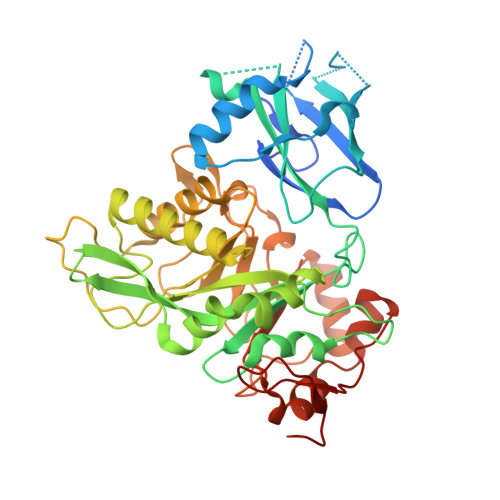Structural basis of mammalian high-mannose N-glycan processing by human gut Bacteroides.
Trastoy, B., Du, J.J., Klontz, E.H., Li, C., Cifuente, J.O., Wang, L.X., Sundberg, E.J., Guerin, M.E.(2020) Nat Commun 11: 899-899
- PubMed: 32060313
- DOI: https://doi.org/10.1038/s41467-020-14754-7
- Primary Citation of Related Structures:
6T8I, 6T8K, 6T8L, 6TCV, 6TCW - PubMed Abstract:
The human gut microbiota plays a central role not only in regulating the metabolism of nutrients but also promoting immune homeostasis, immune responses and protection against pathogen colonization. The genome of the Gram-negative symbiont Bacteroides thetaiotaomicron, a dominant member of the human intestinal microbiota, encodes polysaccharide utilization loci PULs, the apparatus required to orchestrate the degradation of a specific glycan. EndoBT-3987 is a key endo-β-N-acetylglucosaminidase (ENGase) that initiates the degradation/processing of mammalian high-mannose-type (HM-type) N-glycans in the intestine. Here, we provide structural snapshots of EndoBT-3987, including the unliganded form, the EndoBT-3987-Man 9 GlcNAc 2 Asn substrate complex, and two EndoBT-3987-Man 9 GlcNAc and EndoBT-3987-Man 5 GlcNAc product complexes. In combination with alanine scanning mutagenesis and activity measurements we unveil the molecular mechanism of HM-type recognition and specificity for EndoBT-3987 and an important group of the GH18 ENGases, including EndoH, an enzyme extensively used in biotechnology, and for which the mechanism of substrate recognition was largely unknown.
- Structural Biology Unit, Center for Cooperative Research in Biosciences (CIC bioGUNE), Basque Research and Technology Alliance (BRTA), Bizkaia Technology Park, Building 801A, 48160, Derio, Spain. btrastoy@cicbiogune.es.
Organizational Affiliation:



















